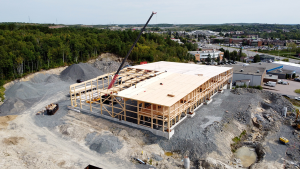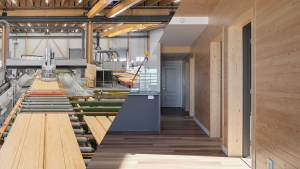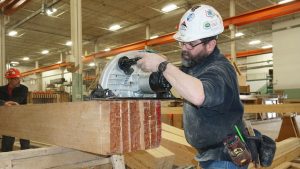Timbertowers are popping up on skylines around the world.
While Ontario has only just approved wood as a material for mid-rise structures up to six storeys, Vancouver architect Michael Green is at the forefront of a push to design and build highrise towers using cross laminated timber (CLT) also known as mass timber.
Green and his team at Michael Green Architecture have already completed the eight-storey Wood Innovation Design Centre (WIDC) in Prince George, B.C. at the University of Northern British Columbia, winning the Royal Architectural Institute of Canada (RAIC) Innovation in Architecture award for 2015. At 29.5 metres, it is North America’s tallest timber building.
Other wood structures are also rising around the world where 10-storeys has been the apex but Green says that will soon be eclipsed. He should know, he literally co-wrote the book on wood towers in 2012, The Case for Tall Wood Building, How Mass Timber Offers a Safe, Economical, and Environmentally Friendly Alternative for Tall Building Structures and has designed a 30-storey wood structure to demonstrate feasibility.
On deck now is a 35-storey wooden tower as part of a massive design contest, Reinventer Paris, in which the French capital has offered 23 sites for innovative design.
Green teamed up with French architects DVVD Paris and developer REI France to design a group of buildings. The status of their submission has yet to be announced but they hope to make the short list.
The push for wood in Ontario triggered a war of words between the wood lobby and the concrete and masonry sector a couple of years ago. Proponents say not only are wood construction costs 10 to 15 per cent lower over masonry, those structures have a dramatically lower carbon footprint, something that may yet come into play beyond bragging rights if carbon taxes or caps are more widely enacted.
"We’ve submitted plans to Paris for what would be the tallest wood structure in the world," he said, adding on the more "fun and playful" side, they’ve just completed a study for a Finnish company showing how the 102-storey Empire State building could be built with CLT. "We think it could though whether you would is another matter."
Similarly, international renowned architects Skidmore, Owings & Merrill’s Timber Tower Research Project has re-envisioned Chicago’s 42-storey Dewitt Chestnut apartment tower, (Skidmore designed it in 1966) as a CLT project.
Innovation aside, to Green it’s all about the environment and sustainability.
"There’s a mandatory requirement that we step up our game," he said. "To be more climate neutral, energy efficient, look at water and other factors. We have to dramatically push the envelope and LEED is not the solution."
The next phase of design has to take all factors into consideration, he said, and it leads back to wood.
He said clients want beautiful buildings which are unique with technology and health and wellness as must haves, which is where wood plays the trump card.
"There are a lot of studies which are clear that wood results in healthier buildings," he said. "Also the economics are a factor. They can be less expensive when planned and designed by teams with experience. A huge part of that is the speed of construction which can be dramatically shorter when compared to other materials and that is also part of the cost saving for the client."
Not all clients share the same motivation, some are driven by cost, others, like a client in Minnesota, want high value tenants who demand unique spaces they can’t get from an office tower.
The first building to break out is considered to be the 2009, Stadthaus in London, England. The eight-storey structure has 29 apartments, built mostly from CLT and was designed by Waugh Thistleton Architects and Techniker engineers.
It used a system developed by Austria’s KLH, which specifies glued timber in perpendicular layers to form panels. Proponents argue there’s less energy consumed in construction.
As an architect, Green said, the form wood can take is limitless and that’s compelling.
"The sky is the limit really in terms of character," he said. "We’re using these high-tech computer cutting machines, highly evolved practices with tolerances within a millimeter which is as good as it gets in construction."
"When you expose the wood, no two pieces can ever be the same, and it’s how you can express the wood which can create incredibly beautiful environments," he said. "When you build with concrete and steel it tends to be fairly monolithic — not always — but it can be. As a designer it makes my job easier because people are naturally drawn to it."
As a species it’s only been in the last century or so that we shifted from stone, wood and earth structures to steel, glass and stone, he said. The wood design movement is a step back to those biological roots, a reaction to the concrete jungles of the 1950s.
Green also has a school, Design Build Research a non-profit which is researching advances in wood construction. More recently, he said, the focus has been on 3D printing — additive manufacturing — to use wood fibre as a material in the process.
"I believe we’ll move a very new scale of building with wood fibre," he said. Initial work involves using polymers with the wood fibre but the goal is to move to all wood on a real life scale.





Recent Comments
comments for this post are closed